Economic Land Utilization Optimization Model
Abstract
1. Introduction
2. Literature Review
2.1. Currect Practice
2.2. Big Data and Sustainable Farming
3. Research Methodology and Framework
4. ELUOM Relational Database
4.1. Crops Database
4.1.1. Crops Classification
4.1.2. Soil Parameters
4.1.3. Water Parameters
4.1.4. Crop Characteristics
4.1.5. Irrigation Systems
4.1.6. Climatic Conditions
4.1.7. Production Factors
5. ELUOM
5.1. Model Logic
- ⮚
- Soil factors including:
- ○
- soil type compatibility
- ○
- ESP tolerance range
- ○
- Acceptable minimum soil depth
- ○
- and pH tolerance limits
- ⮚
- Water parameters including:
- ○
- crop’s maximum EC limit
- ○
- chloride & boron content in soil
5.2. Financial Data
6. Model Mathematical Formulas
6.1. First Filtration Phase
- (1)
- Soil Parameters
- ○
- Soil type compatibility requirement
- ○
- Exchangeable Sodium percentage Requirement
- ○
- Soil Depth requirement
- ○
- pH requirement
- (2)
- Water Parameters
- ○
- Water Ec requirement
- ○
- Chloride requirement
- ○
- Boron requirement
6.1.1. Soil Parameters
Soil Compatibility
Exchangeable Sodium Percentage
Soil Depth Requirement
pH Requationuirement
6.1.2. Water Parameters
Electric Conductivity (EC)
Chloride Level
Boron Level
6.2. Second Filtration Phase
6.2.1. Filtration Logic
6.2.2. Second Filtration Phase Output
6.3. Optimization
6.3.1. Variables
6.3.2. Constraints
- Sum of feddans to be planted should be equal or less than total land area for each month
- Sum of feddans planted per crop should be equal or less than maximum area allowed per crop (if determined by user)
- Sum of number of crops to be planted should be equal or less than Maximum Allowed no. of crops to be planted in a land (user determined)
- Sum of water needs for crops to be planted should be equal or less than maximum available water per day
- Sum of costs needs for crops cultivation & Greenhouse construction & operations should be equal or less than maximum available capital
- Land Availability Constraints
- 2.
- Water Availability Constraint
- 3.
- Crop Area User Limitation Constraint
- 4.
- Crop Variety User Limitation Constraint
- 5.
- Budget Availability Constraint
6.3.3. Objective Function
7. Model Interface
8. Model Validation and Verification
8.1. Overview
8.2. Current Agricultural Practices at Giza Land
8.3. Model Validation
8.4. Model Optimization Verification
8.5. Results & Discussion of Current Versus Recommended Agricultural Practices
9. Case Study Application
9.1. Overview
9.2. Data Input
9.3. Filtration Phase
9.4. Optimization Phase Result
10. Conclusions and Recommendation
Author Contributions
Funding
Institutional Review Board Statement
Informed Consent Statement
Data Availability Statement
Conflicts of Interest
References
- McCarl, B.; Musumba, M.; Smith, J.; Kirshen, P.; Jones, R.; El-Ganzori, A.; Ali, M.; Kotb, M.; El-Shinnawy, I.; El-Agizy, M.; et al. Climate change vulnerability and adaptation strategies in Egypt’s agricultural sector. Mitig. Adapt. Strateg. Glob. Chang. 2015, 20, 1097–1109. [Google Scholar] [CrossRef]
- Hosny, O.; Dorra, E.; Tarabieh, K.; Nassar, K.; Zahran, S.; Amer, M. Quantifying the Social Impact of a Pilot Sustainable and Environmentally Friendly Optimizer for Urban Landscaping (SEOUL). In Proceedings of the 3rd Energy for Sustainability International Conference, Funchal, Portugal, 8–10 February 2017. [Google Scholar]
- ECPGR. ECPGR Central Crop Databases and Other Crop Databases. 2020. Available online: https://www.ecpgr.cgiar.org/resources/germplasm-databases/ecpgr-central-crop-databases/ (accessed on 18 February 2020).
- FAO. Land and Water, Food Agric. Organ. United Nations. 2020. Available online: http://www.fao.org/land-water/databases-and-software/crop-information/en/ (accessed on 18 February 2020).
- Ryu, M.; Yun, J.; Miao, T.; Ahn, I.; Choi, S.; Kim, J. Design and implementation of a connected farm for smart farming system. In Proceedings of the 2015 IEEE SENSORS, Online, 1–4 November 2015. [Google Scholar] [CrossRef]
- Lu, L.; Tian, G.; Hatzenbuehler, P. How agricultural economists are using big data: A review. China Agric. Econ. Rev. 2022, 14, 494–508. [Google Scholar] [CrossRef]
- Bhat, S.A.; Huang, N.F. Big Data and AI Revolution in Precision Agriculture: Survey and Challenges. IEEE Access 2021, 9, 110209–110222. [Google Scholar] [CrossRef]
- Wolfert, S.; Ge, L.; Verdouw, C.; Bogaardt, M. Big Data in Smart Farming—A review. Agric. Syst. 2017, 153, 69–80. [Google Scholar] [CrossRef]
- Hosny, O.; El Eslamboly, A.; Dorra, E.; Tarabieh, K.; Abotaleb, I.; Amer, M.; Farouk, M.; Gad, H.; Hassan, M.; Mansour, S.; et al. Developing a comprehensive relational database for optimizing land utilization for sustainable farming. In Proceedings of the Canadian Society of Civil Engineering Annual Conference 2021: CSCE21 General Track Volume 1; Springer Nature: Singapore, 2022; pp. 391–403. [Google Scholar]
- Albrecht, G.; Ketterings, Q.; Beckman, J. Soil pH for Field Crops. Agronomy Fact Sheet Series. 2005. Available online: http://www.nnyagdev.org/PDF/SoilpH.pdf (accessed on 18 February 2022).
- Evangelou, V.; MacDonald, L. Handbook of Plant and Crop Physiology, Second Edition, Revised and Expanded. In Crop Science; Pessarakl, M., Ed.; Marcel Dekker: New York, NY, USA, 2002; pp. 17–50. [Google Scholar] [CrossRef]
- Tam, S.; Petersen, A. B.C. Sprinkler Irrigation Manual; van der Gulik, T.W., Ed.; British Columbia Ministry of Agriculture: Victoria, BC, USA, 2014. [Google Scholar]
- Kuriakose, S.; Devkota, S.; Rossiter, D.; Jetten, V. Prediction of soil depth using environmental variables in an anthropogenic landscape, a case study in the Western Ghats of Kerala, India. Catena 2009, 79, 27–38. [Google Scholar] [CrossRef]
- Wang, Q.; Wu, B.; Stein, A.; Zhu, L.; Zeng, Y. Soil depth spatial prediction by fuzzy soil-landscape model. J. Soils Sedim. 2018, 18, 1041–1051. [Google Scholar] [CrossRef]
- Bauder, T.; Waskom, R.; Sutherland, P.; Davis, R. Irrigation Water Quality Criteria—0.506, Color. State Univ. Extension. 2020. Available online: https://extension.colostate.edu/topic-areas/agriculture/irrigation-water-quality-criteria-0-506/ (accessed on 18 February 2020).
- Conklin, A.R. Introduction to Soil Chemistry; Wiley: Hoboken, NJ, USA, 2005. [Google Scholar] [CrossRef]
- FAO/NRCB. Length of the Growing Season. 2014. Available online: http://www.fao.org/nr/climpag/cropfor/lgp_en.asp (accessed on 5 February 2020).
- Brouwer, C.; Prins, K.; Kay, M.; Heibloem, M. Chapter 7. Choosing an Irrigation Method. Irrig. Water Manag. Train. Man. 2014. Available online: http://www.fao.org/3/S8684E/s8684e08.htm (accessed on 7 February 2020).
- Tandazo-Yunga, J.; Ruiz-González, M.; Rojas, J.; Capa-Mora, E.; Prohens, J.; Alejandro, J.; Acosta-Quezada, P. The impact of an extreme climatic disturbance and different fertilization treatments on plant development, phenology, and yield of two cultivar groups of Solanum betaceum Cav. PLoS ONE 2017, 12, e0190316. [Google Scholar] [CrossRef]
- Hosny, O.; Dorra, E.; El-Eslamboly, K.; Tarabieh, A.; Abotaleb, I.; Amer, M.; Farouk, M.; Gad, H.; El Raouf, Y.A.; Sherif, A.; et al. Designing an Automated Multi-Objective Optimization Model for Integrated and Sustainable Farming. In Proceedings of the Construction Research Congress 2022, Arlington, VA, USA, 9–12 March 2022. [Google Scholar]
- NetGenium. (n.d.); Hydrus, P.C. Available online: https://www.pc-progress.com/en/Default.aspx?hydrus (accessed on 11 January 2023).
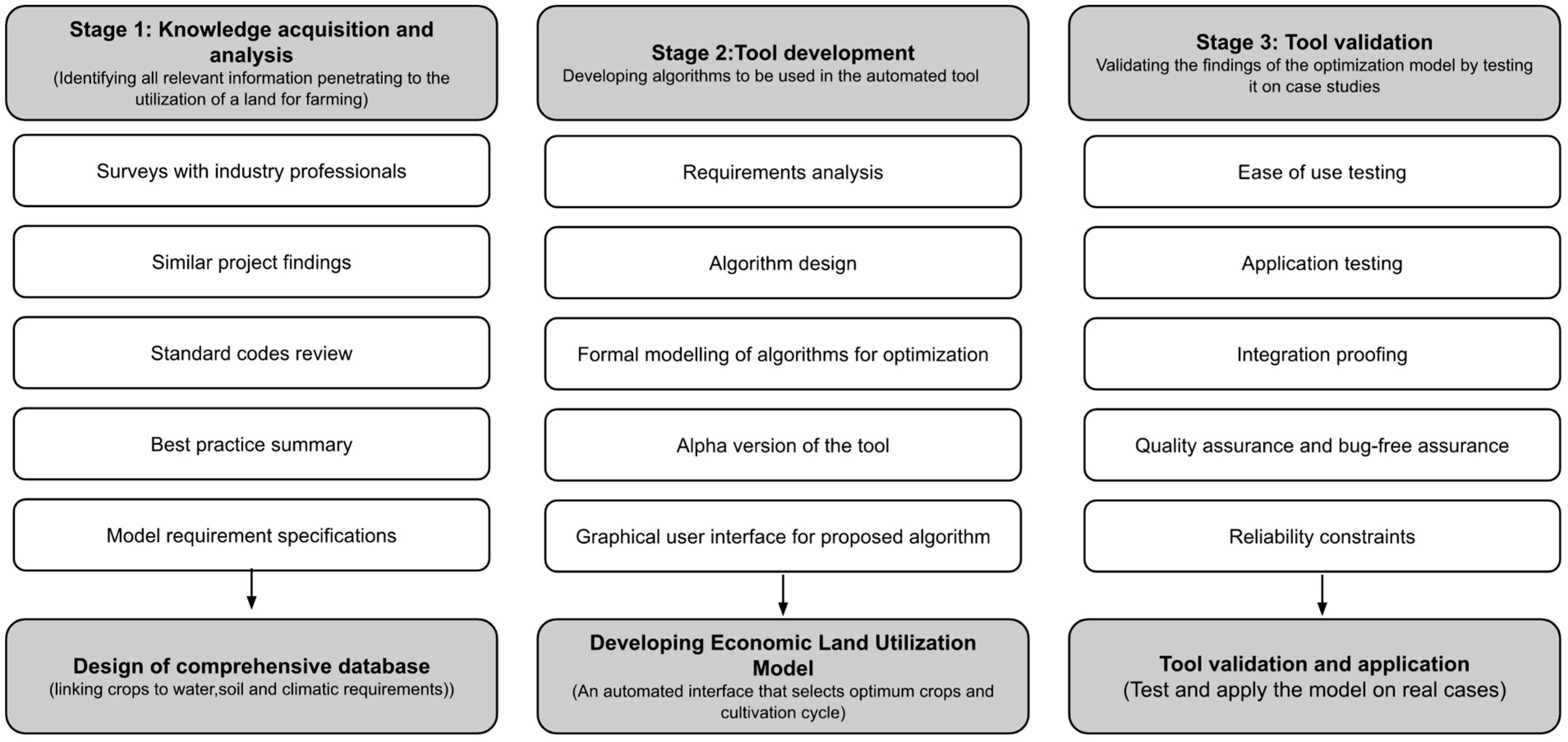
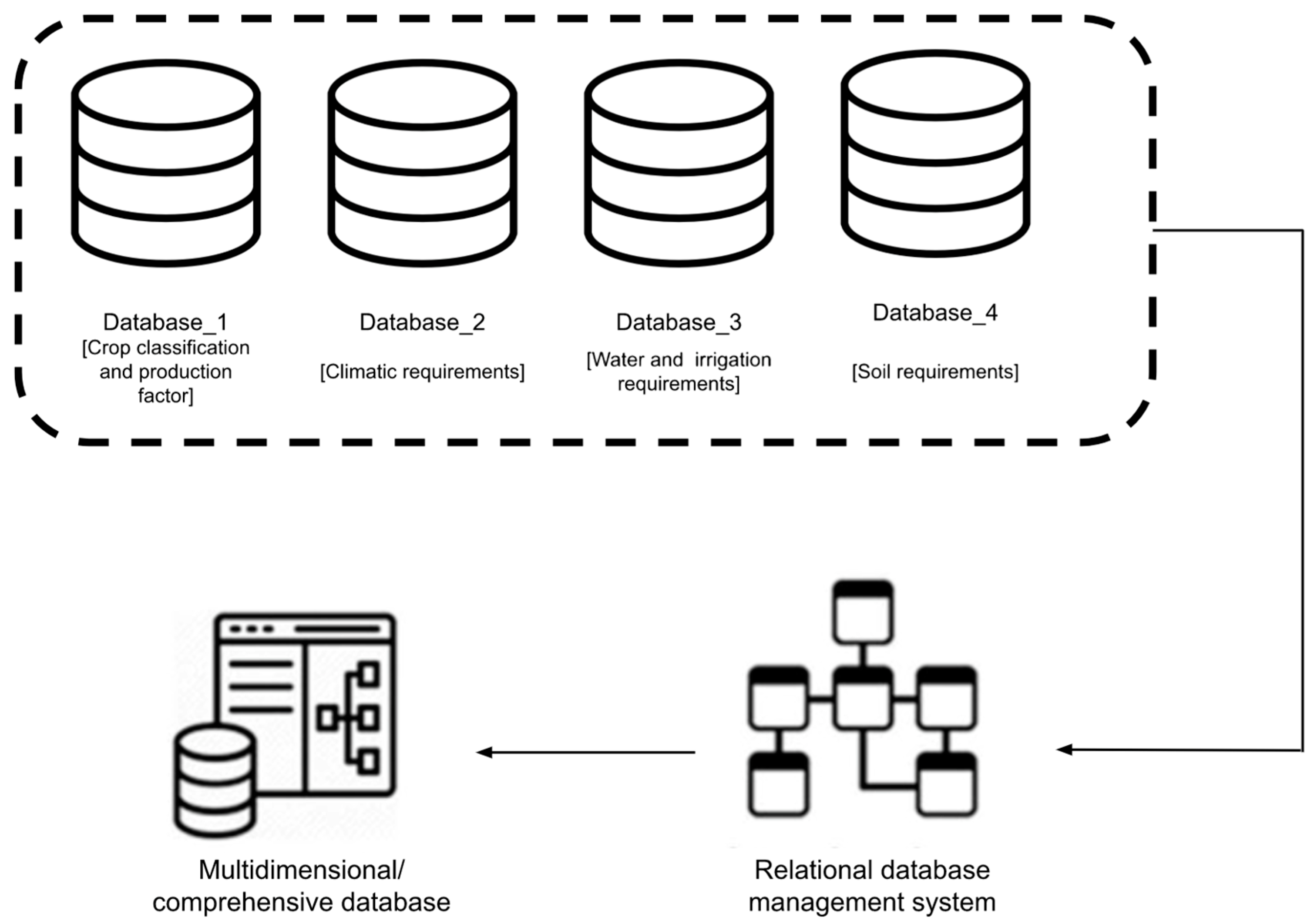
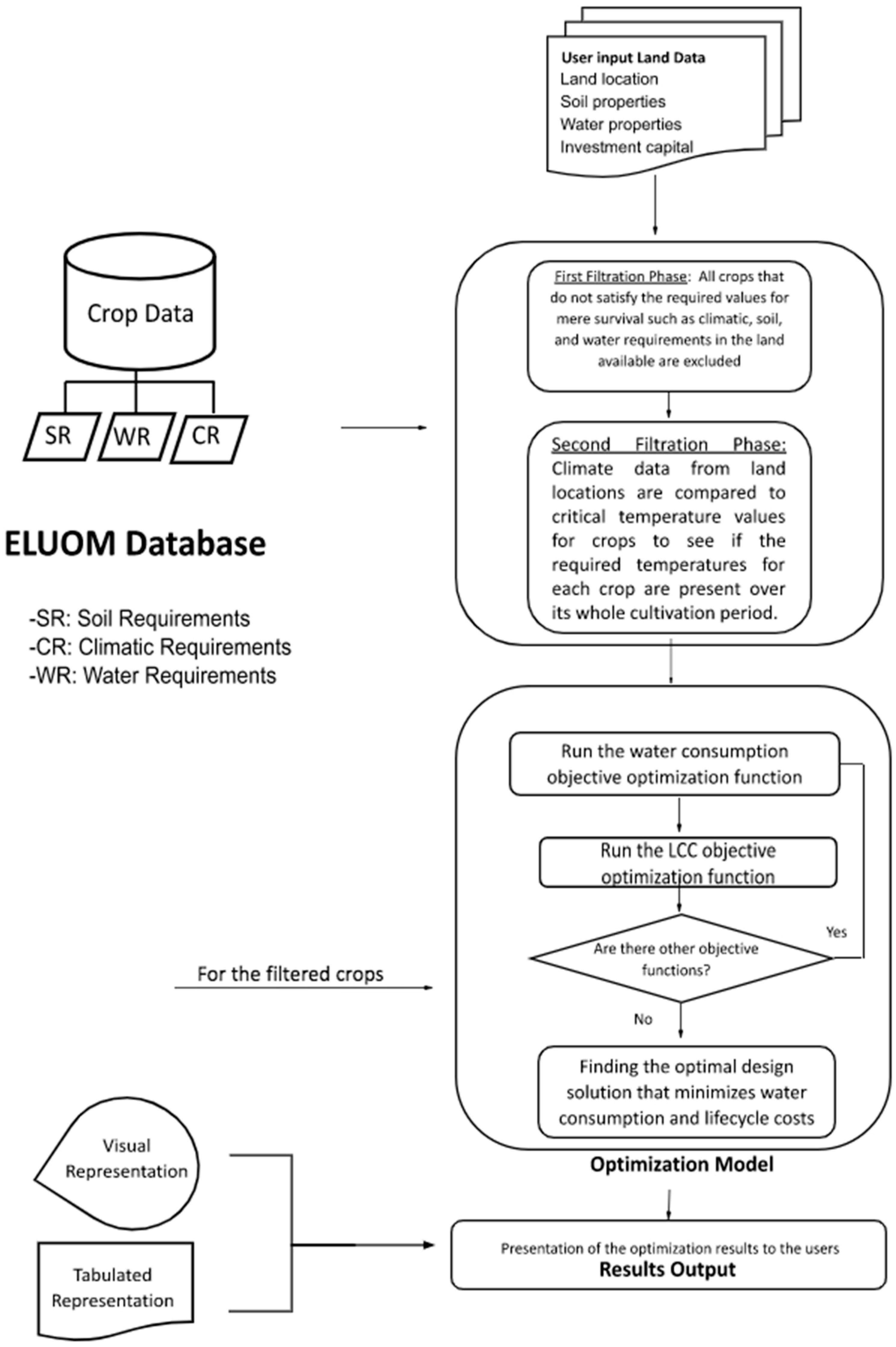
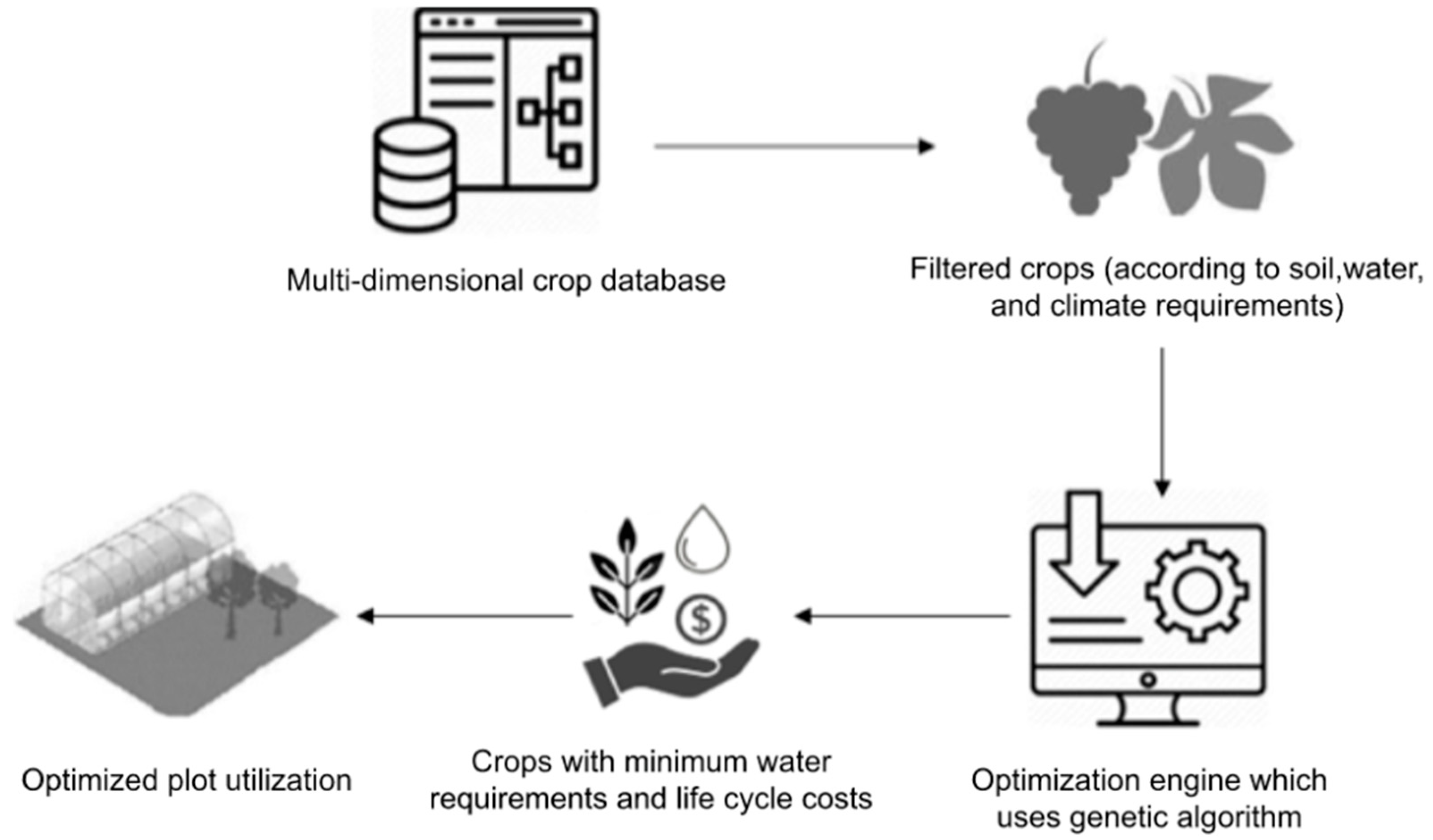


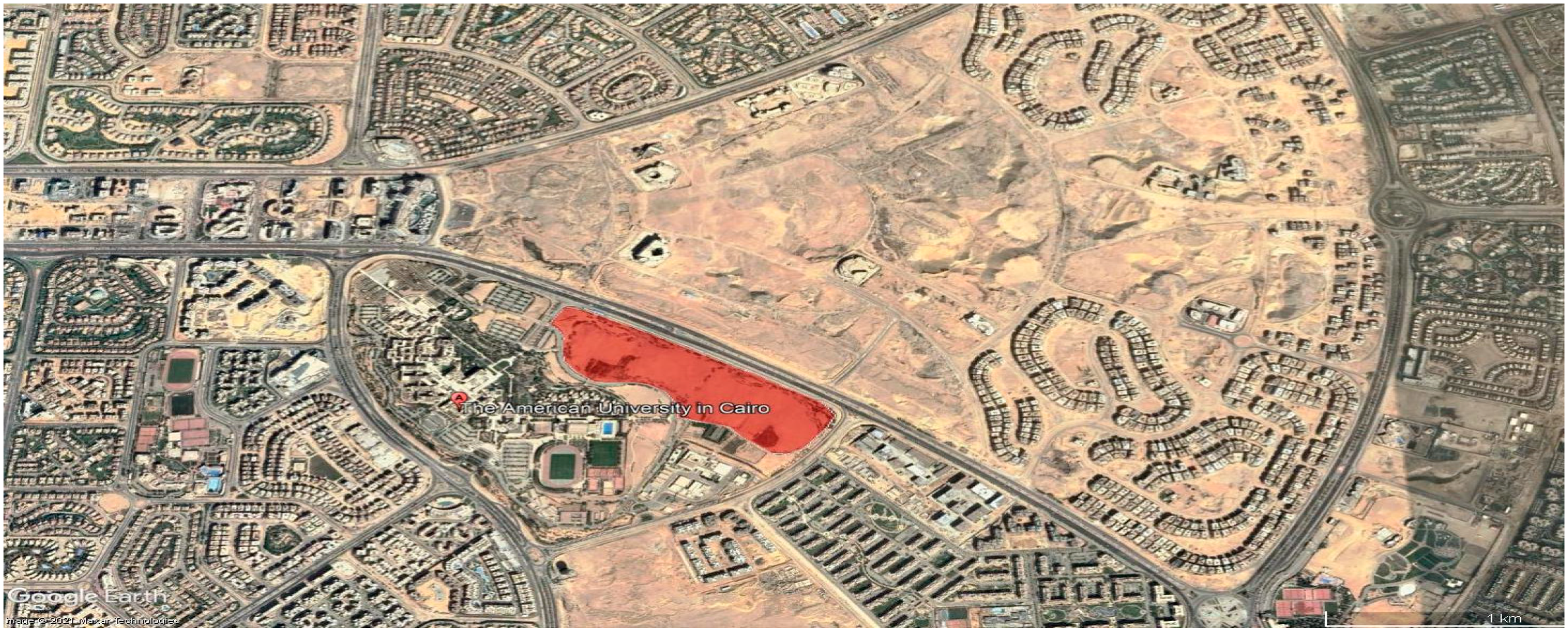
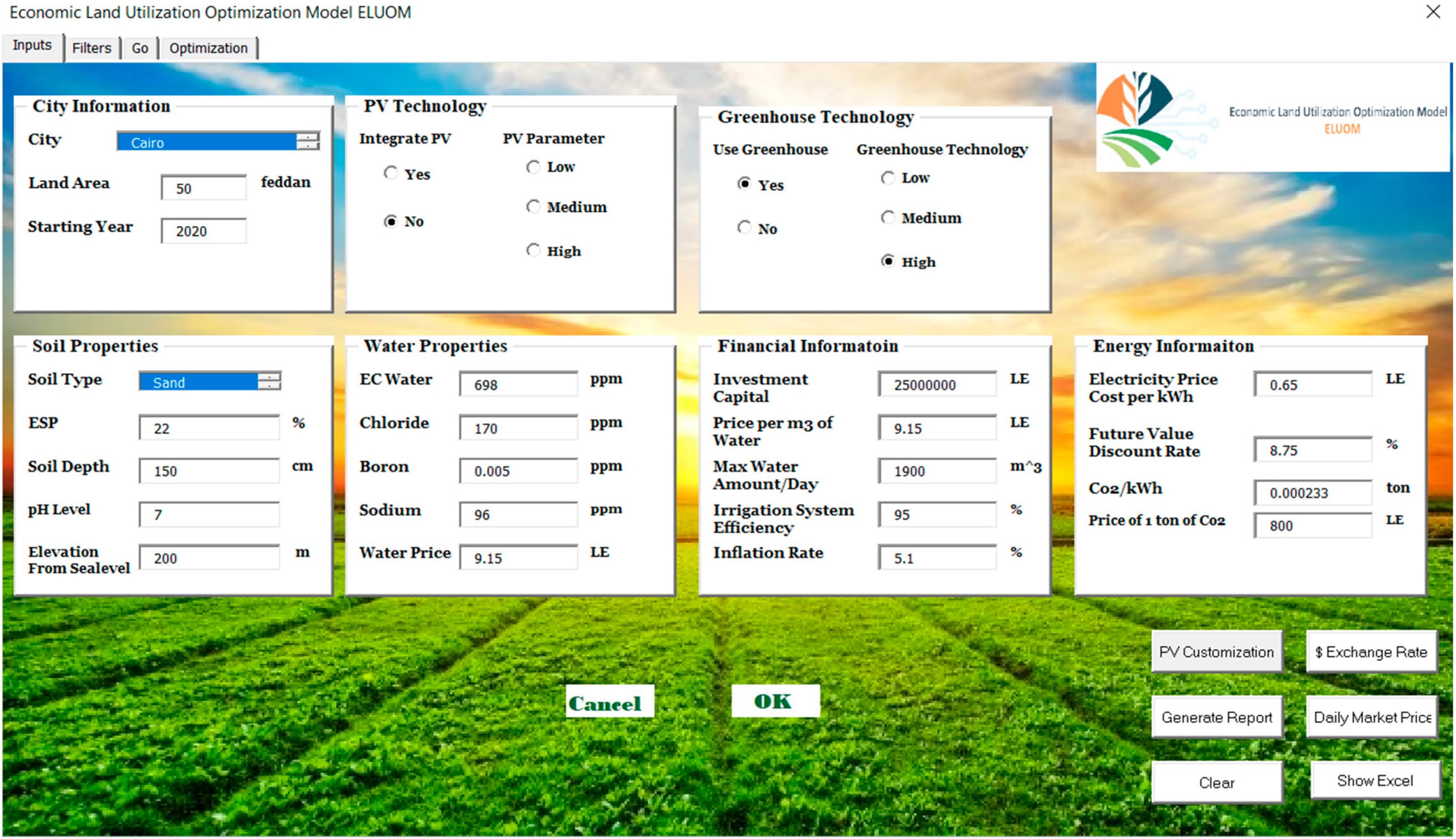
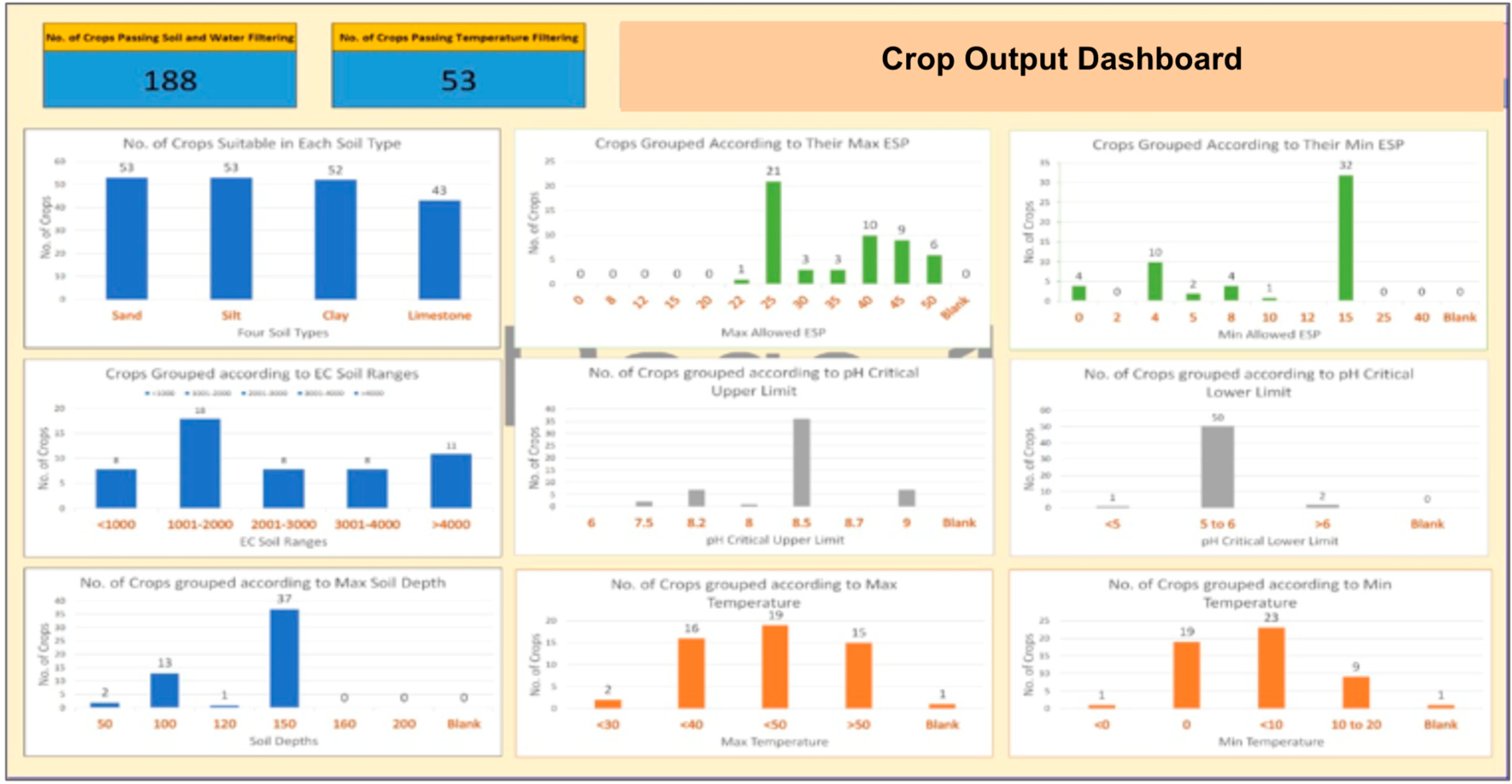
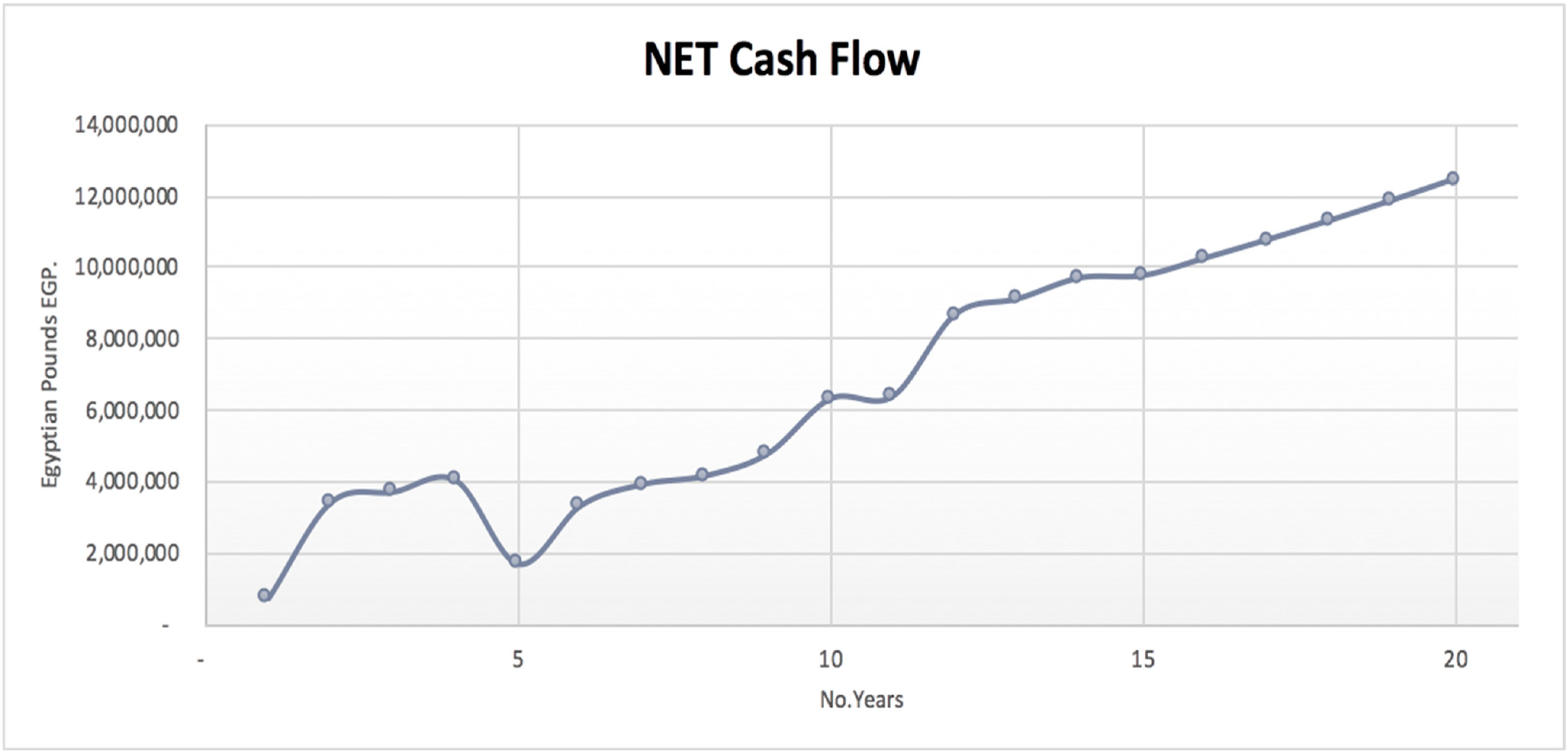
| Parameter | Value | Unit |
|---|---|---|
| Objective function-expected NPV (20 years) | 4,706,351.00 | LE |
| Estimated initial investment | 511,887.00 | LE |
| Estimated first year revenue | 258,341.00 | LE |
| Estimated water quantity used/year | 146,112 | m3 |
| Average daily water quantity | 400 | m3/day |
| Max land utilization percentage | 100 | % |
| Return/water unit | 32.2 | LE/m3 |
| Month | Jan | Feb | Mar | Apr | May | Jun | Jul | Aug | Sep | Oct | Nov | Dec |
|---|---|---|---|---|---|---|---|---|---|---|---|---|
| % Land Utilization | 100 | 100 | 100 | 100 | 100 | 0 | 100 | 100 | 100 | 100 | 0 | 0 |
| Peas (Feddan) | 30 | 30 | 30 | 30 | 30 | 0 | 0 | 0 | 0 | 0 | 0 | 0 |
| Cucumber (Feddan) | 0 | 0 | 0 | 0 | 0 | 0 | 30 | 30 | 30 | 30 | 0 | 0 |
| Month | Jan | Feb | Mar | Apr | May | Jun | Jul | Aug | Sep | Oct | Nov | Dec |
|---|---|---|---|---|---|---|---|---|---|---|---|---|
| % Land Utilization | 97 | 97 | 63 | 63 | 63 | 63 | 97 | 97 | 97 | 97 | 63 | 97 |
| Sweet potatoes (Feddan) | 0 | 0 | 0 | 0 | 0 | 0 | 10 | 10 | 10 | 10 | 0 | 0 |
| Beet (Feddan) | 10 | 10 | 0 | 0 | 0 | 0 | 0 | 0 | 0 | 0 | 0 | 10 |
| Lemon pompon (Feddan) | 10 | 10 | 10 | 10 | 10 | 10 | 10 | 10 | 10 | 10 | 10 | 10 |
| Bananas (Feddan) | 9 | 9 | 9 | 9 | 9 | 9 | 9 | 9 | 9 | 9 | 9 | 9 |
| Parameter | Value | Unit |
|---|---|---|
| Objective function-expected NPV (20 years) | 18,505,969.00 | LE |
| Estimated initial investment | 1,498,280.00 | LE |
| Estimated first year revenue | 920,290.00 | LE |
| Estimated water quantity used/year | 151,996 | m3 |
| Average daily water quantity | 415.5 | m3/day |
| Land utilization percentage | 97 | % |
| Return/water unit | 122.71 | LE/m3 |
| Parameter | Current Practices | ELUOM Suggestion |
|---|---|---|
| Objective function: expected 20-year NPV (LE) | 706,351.00 | 18,505,969.00 |
| Estimated initial investment (LE) | 511,887.00 | 1,498,280.00 |
| Estimated first year revenue (LE) | 258,341.00 | 920,290.00 |
| Estimated water quantity used/year (m3) | 146,112 | 151,996 |
| Average daily water quantity (m3/day) | 400 | 415.5 |
| Land utilization percentage (%) | 100 | 97 |
| Return/water unit (LE/m3) | 32.2 | 122.71 |
| No. | Crop Name | Tree (Y/N) | No. | Crop Name | Tree (Y/N) |
|---|---|---|---|---|---|
| 1 | Date palm | 1 | 22 | Pistachio | 1 |
| 2 | Date palm Wet | 1 | 23 | Papaya | 1 |
| 3 | Date palm Dry | 1 | 24 | Balsam apple | 0 |
| 4 | Date palm Half Dry | 1 | 25 | Balsam-pear | 0 |
| 5 | Olive | 1 | 26 | Kiwano (Horned melon) | 0 |
| 6 | Bitter orange | 1 | 27 | Chinese Water Chestnut | 1 |
| 7 | Lemon pompon | 1 | 28 | Dry Broad Bean | 0 |
| 8 | Lemon | 1 | 29 | Celery | 0 |
| 9 | Sweet Lemon | 1 | 30 | Potato | 0 |
| 10 | Mandarins | 1 | 31 | Wheat | 0 |
| 11 | Alkmkuat | 1 | 32 | Barley | 0 |
| 12 | Almond | 1 | 33 | Clover | 0 |
| 13 | Bananas | 1 | 34 | Italian Rye-grass | 0 |
| 14 | Mango | 1 | 35 | Corn summer | 0 |
| 15 | Mango New Varieties | 1 | 36 | Maize | 0 |
| 16 | carob | 1 | 37 | Sugar beet | 0 |
| 17 | Guava | 1 | 38 | Soybean | 0 |
| 18 | Pear | 1 | 39 | Beet | 0 |
| 19 | Kiwi | 1 | 40 | Bardqosh | 0 |
| 20 | Passion Cocktail | 1 | 41 | Anise | 0 |
| 21 | Pecan | 1 |
| Month | Jan | Feb | Mar | Apr | May | Jun | Jul | Aug | Sep | Oct | No | Dec |
|---|---|---|---|---|---|---|---|---|---|---|---|---|
| % Land Utilization | 80 | 98 | 98 | 98 | 62 | 62 | 100 | 100 | 100 | 100 | 62 | 62 |
| Date palmtrees (Feddan) | 0.85 | 0.85 | 0.85 | 0.85 | 0.85 | 0.85 | 0.85 | 0.85 | 0.85 | 0.85 | 0.85 | 0.85 |
| Lemon (Feddan) | 20 | 20 | 20 | 20 | 20 | 20 | 20 | 20 | 20 | 20 | 20 | 20 |
| Bananas (Feddan) | 10 | 10 | 10 | 10 | 10 | 10 | 10 | 10 | 10 | 10 | 10 | 10 |
| Potato (Feddan) | 9 | 9 | 9 | 9 | 0 | 0 | 0 | 0 | 0 | 0 | 0 | 0 |
| Maize (Feddan) | 0 | 0 | 0 | 0 | 0 | 0 | 19 | 19 | 19 | 19 | 0 | 0 |
| Beet (Feddan) | 0 | 9 | 9 | 9 | 0 | 0 | 0 | 0 | 0 | 0 | 0 | 0 |
| Parameter | Value | Unit |
|---|---|---|
| Objective function-expected NPV (20 years) | 72,665,937.00 | LE |
| Estimated initial investment | 2,459,027.00 | LE |
| Estimated first year revenue | 3,219,165.00 | LE |
| Estimated water quantity used/year | 411,226 | m3 |
| Average daily water quantity | 1,126.65 | m3/day |
| Land utilization percentage | 100 | % |
Disclaimer/Publisher’s Note: The statements, opinions and data contained in all publications are solely those of the individual author(s) and contributor(s) and not of MDPI and/or the editor(s). MDPI and/or the editor(s) disclaim responsibility for any injury to people or property resulting from any ideas, methods, instructions or products referred to in the content. |
© 2023 by the authors. Licensee MDPI, Basel, Switzerland. This article is an open access article distributed under the terms and conditions of the Creative Commons Attribution (CC BY) license (https://creativecommons.org/licenses/by/4.0/).
Share and Cite
Hosny, O.A.; Dorra, E.M.; Tarabieh, K.A.; El Eslamboly, A.; Abotaleb, I.; Amer, M.; Gad, H.K.; Farouk, M.; Abd El Raouf, Y.; Sherif, A.; et al. Economic Land Utilization Optimization Model. Sustainability 2023, 15, 2594. https://doi.org/10.3390/su15032594
Hosny OA, Dorra EM, Tarabieh KA, El Eslamboly A, Abotaleb I, Amer M, Gad HK, Farouk M, Abd El Raouf Y, Sherif A, et al. Economic Land Utilization Optimization Model. Sustainability. 2023; 15(3):2594. https://doi.org/10.3390/su15032594
Chicago/Turabian StyleHosny, Ossama A., Elkhayam M. Dorra, Khaled A. Tarabieh, Ahmed El Eslamboly, Ibrahim Abotaleb, Mariam Amer, Heba Kh. Gad, Mostafa Farouk, Youmna Abd El Raouf, Adham Sherif, and et al. 2023. "Economic Land Utilization Optimization Model" Sustainability 15, no. 3: 2594. https://doi.org/10.3390/su15032594
APA StyleHosny, O. A., Dorra, E. M., Tarabieh, K. A., El Eslamboly, A., Abotaleb, I., Amer, M., Gad, H. K., Farouk, M., Abd El Raouf, Y., Sherif, A., & Hussein, Y. (2023). Economic Land Utilization Optimization Model. Sustainability, 15(3), 2594. https://doi.org/10.3390/su15032594









